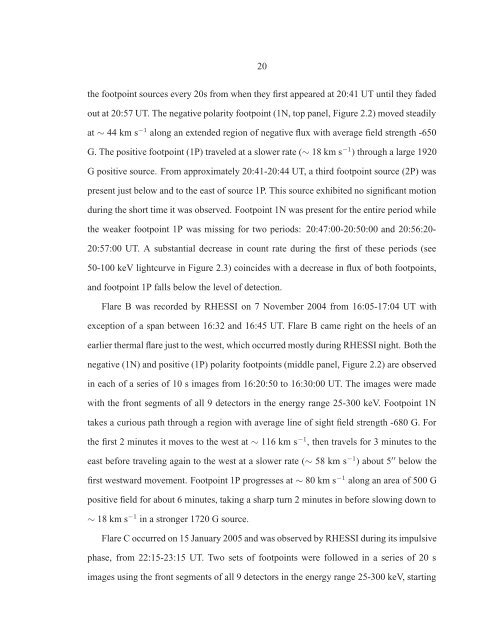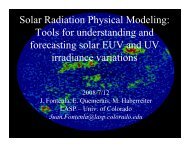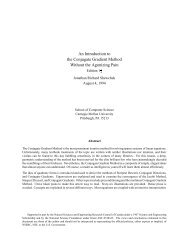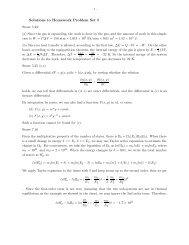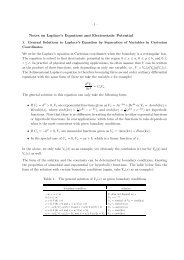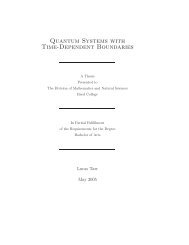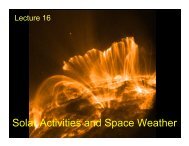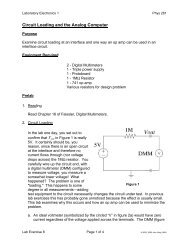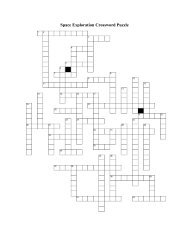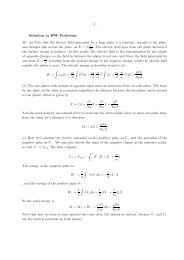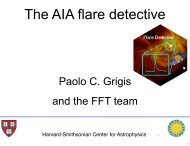The Topology of Magnetic Reconnection in Solar Flares
The Topology of Magnetic Reconnection in Solar Flares
The Topology of Magnetic Reconnection in Solar Flares
Create successful ePaper yourself
Turn your PDF publications into a flip-book with our unique Google optimized e-Paper software.
20the footpo<strong>in</strong>t sources every 20s from when they first appeared at 20:41 UT until they fadedout at 20:57 UT. <strong>The</strong> negative polarity footpo<strong>in</strong>t (1N, top panel, Figure 2.2) moved steadilyat ∼ 44 km s −1 along an extended region <strong>of</strong> negative flux with average field strength -650G. <strong>The</strong> positive footpo<strong>in</strong>t (1P) traveled at a slower rate (∼ 18 km s −1 ) through a large 1920G positive source. From approximately 20:41-20:44 UT, a third footpo<strong>in</strong>t source (2P) waspresent just below and to the east <strong>of</strong> source 1P. This source exhibited no significant motiondur<strong>in</strong>g the short time it was observed. Footpo<strong>in</strong>t 1N was present for the entire period whilethe weaker footpo<strong>in</strong>t 1P was miss<strong>in</strong>g for two periods: 20:47:00-20:50:00 and 20:56:20-20:57:00 UT. A substantial decrease <strong>in</strong> count rate dur<strong>in</strong>g the first <strong>of</strong> these periods (see50-100 keV lightcurve <strong>in</strong> Figure 2.3) co<strong>in</strong>cides with a decrease <strong>in</strong> flux <strong>of</strong> both footpo<strong>in</strong>ts,and footpo<strong>in</strong>t 1P falls below the level <strong>of</strong> detection.Flare B was recorded by RHESSI on 7 November 2004 from 16:05-17:04 UT withexception <strong>of</strong> a span between 16:32 and 16:45 UT. Flare B came right on the heels <strong>of</strong> anearlier thermal flare just to the west, which occurred mostly dur<strong>in</strong>g RHESSI night. Both thenegative (1N) and positive (1P) polarity footpo<strong>in</strong>ts (middle panel, Figure 2.2) are observed<strong>in</strong> each <strong>of</strong> a series <strong>of</strong> 10 s images from 16:20:50 to 16:30:00 UT. <strong>The</strong> images were madewith the front segments <strong>of</strong> all 9 detectors <strong>in</strong> the energy range 25-300 keV. Footpo<strong>in</strong>t 1Ntakes a curious path through a region with average l<strong>in</strong>e <strong>of</strong> sight field strength -680 G. Forthe first 2 m<strong>in</strong>utes it moves to the west at ∼ 116 km s −1 , then travels for 3 m<strong>in</strong>utes to theeast before travel<strong>in</strong>g aga<strong>in</strong> to the west at a slower rate (∼ 58 km s −1 ) about 5 ′′ below thefirst westward movement. Footpo<strong>in</strong>t 1P progresses at ∼ 80 km s −1 along an area <strong>of</strong> 500 Gpositive field for about 6 m<strong>in</strong>utes, tak<strong>in</strong>g a sharp turn 2 m<strong>in</strong>utes <strong>in</strong> before slow<strong>in</strong>g down to∼ 18 km s −1 <strong>in</strong> a stronger 1720 G source.Flare C occurred on 15 January 2005 and was observed by RHESSI dur<strong>in</strong>g its impulsivephase, from 22:15-23:15 UT. Two sets <strong>of</strong> footpo<strong>in</strong>ts were followed <strong>in</strong> a series <strong>of</strong> 20 simages us<strong>in</strong>g the front segments <strong>of</strong> all 9 detectors <strong>in</strong> the energy range 25-300 keV, start<strong>in</strong>g


